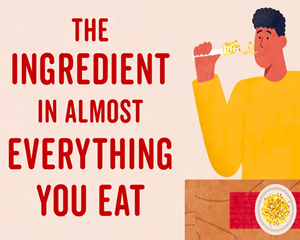In the 1930s, American industrialist Henry Ford had one overwhelming obsession: soybeans.
20世纪30年代,美国实业家亨利·福特疯狂地迷恋上了一样东西:大豆。
He extracted their oil to make enamel for painting his cars. He crushed them into powder to make plastic parts.
他从大豆中提取豆油,制作福特汽车喷漆用的珐琅漆。他将大豆碾压成粉末制作塑料零部件。
And he encouraged American farmers to grow as much of the plant as possible.
他还鼓励美国农民尽可能地多种植这种植物。
But he wasn't just feeding soy to machines. At the Chicago World's Fair, he hosted a soy-centric feast.
他不仅仅给将大豆用在机械上面,还在芝加哥世界博览会上,举办了一场大豆主题的宴会。
The ingredient had been a staple in Asian cuisine for centuries,
几个世纪以来,大豆一直是亚洲菜选用的主要食材。
but Ford's dinner -- full of soy substitutes for dairy, meat and wheat -- took the integration of soy into food a step further.
而福特的宴会上--全都是大豆制成的乳制品、肉类和小麦替代品--使得大豆在食物中的应用更进一步。
Today, soy is in so many foods that most people consume it every day without even knowing it.
如今,许多食物中都含有大豆成分,大多数人每天都在不知不觉中食用它。
So what makes soybeans so versatile? And is our global obsession healthy or harmful?
那为什么大豆用途如此广泛呢?风靡全世界的大豆究竟是有益健康还是有害健康?
Soybeans have been cultivated in Asia as early as 5,500 years ago, but since then they've spread across the globe.
早在5500年前,亚洲地区就开始种植大豆,此后大豆在世界范围内都有种植。
Part of soy's success is that the crop can be grown easily and cheaply in variable conditions.
大豆席卷世界的部分原因在于这种农作物能够适应多变的环境并且种植成本低。
And once they're grown, soybeans have an incredibly high density of proteins and fats;
而且成熟的大豆,蛋白质和脂肪的含量非常高,
ingredients which in recent years have been used in everything from mayonnaise to biodegradable plastic.
而这些成分近年来被广泛使用,从蛋黄酱到生物降解塑料,不一而足。
The ideal method for separating these components depends on what you're trying to extract.
分离出这些成分的理想方法取决于你想提取什么。
To isolate soy proteins, dehulled beans are sometimes pressed through rollers to create thin flakes, and then steeped in water to draw out the proteins.
为了分离出大豆蛋白,有时会用滚筒将脱皮的大豆挤压成薄片,然后将它们浸泡在水中以提取蛋白质。
Alternatively, whole beans can be simply soaked and ground into a whitish, protein rich liquid.
或者,对未经加工的大豆进行简单地浸泡和碾压,使之流出蛋白质含量丰富的白色液体。
In both cases, the resulting substance can be used to make spongy foods like tofu or filtered to produce soymilk.
这两种方法生产的物质可以用来制作豆腐之类的松软食物,或者再经过滤后生产豆浆。
And at the industrial scale, these proteins can be used in various ways to help make processed foods.
在工业生产中,可以通过多种方式利用这些蛋白质制作加工食品。
Soy fats may be even more versatile. In one extraction method, soybeans are dried, cleaned, and then fed into an extruder.
大豆脂肪的用途可能更为广泛。有一种提炼方法中是,将大豆烘干、洗净,送入挤压机。
This machine simultaneously heats and presses the beans, producing a liquid containing soy oil and other fatty components.
机器会在加热豆子的同时,压榨豆子,流出的液体含有豆油和其他脂肪成分。
By adding water and spinning the mixture, components are separated into two parts:
经过加水和旋转分离后,这些成分会被分成两部分:
refined soy oil for things like salad dressing, and a substance called lecithin.
可以用来制作沙拉酱等的精练豆油,以及一种叫做卵磷脂的物质。

Lecithin is made of molecules called phospholipids, which have a phosphate head that attracts water and a tail that attracts fats.
卵磷脂由磷脂分子组成,它的一端亲水,另一端亲油。
These features make phospholipids excellent for blending ingredients that naturally separate from each other.
由于具备这些特性,磷脂非常适合用来混合那些不相溶的成分。
This process is called emulsification and soy lecithins are used as an emulsifying agent in a huge variety of foods.
这一过程称为乳化,大豆卵磷脂在很多种食品生产过程中被用作乳化剂。
For example, during chocolate production phospholipids attach to both the fatty components of the cocoa butter and the water-soluble sugar particles,
例如,在巧克力生产过程中,磷脂会附着在可可脂和水溶性糖颗粒的脂肪成分上,
making them easier to combine into a smooth mixture.
促进它们结合形成表面光滑的混合物。
A similar process happens in powdered products that need to be instantly rehydrated.
在生产需要及时加水的粉状产品时也会发生类似的情况。
Soy lecithin bonds with the water and helps the powder disperse more quickly.
大豆卵磷脂与水结合,加速粉末分离。
While there are other plants we can process for lecithin and proteins,
虽然还有其他植物可以用来加工生产卵磷脂和蛋白质,
soy's mild taste and widespread availability have earned it a place in thousands of food products.
但大豆因其口感柔和,用途广泛,在成千上万的加工食品中赢得了自己的一席之地。
But is it unhealthy to be eating this much soy? Not really.
不过食用这么多大豆不会有害健康吗?并不会。
Soybeans contain many of the essential amino acids our bodies need, making them one of the best ways to get these proteins without eating meat.
大豆中含有许多人体必需的氨基酸,因而食用大豆是不用吃肉就可以获取这些蛋白质的最佳方式。
And the beans' fat content is largely made up of so-called "good" fats
大豆脂肪主要由所谓的“有益”脂肪组成,
poly and mono-unsaturated fatty acids, which can decrease cholesterol and reduce the risk of heart disease.
多不饱和脂肪酸与单不饱和脂肪酸,它们可以降低胆固醇,同时降低患心脏病的风险。
There are some compounds in soy that may inhibit our body's absorption of various minerals.
大豆中的一些化合物可能会抑制我们身体对多种矿物质的吸收。
And about 0.3% of the general population has a soy allergy, which can be severe in rare cases.
大约0.3%的人对大豆过敏,极少数情况下,会产生严重的过敏症状。
But for many people, the biggest complaint about soy consumption is the occasional increase in flatulence.
但对大多数人来说,食用大豆最常见的后果是胀气的情况会偶有增加。
Outside our bodies however, soy is much more worrying.
然而,大豆对我们身体以外的影响更令人担忧。
To accommodate the soy farms needed for heavy industry, processed foods and livestock feed, huge swaths of land have been deforested.
为了种植大豆,给重工业、加工食品、牲畜饲料提供生产原料,大片树木被砍伐。
Between 2006 and 2017, roughly 22,000 square kilometers of the Amazon were cleared for soy production.
2006年至2017年间,亚马逊地区约有22000平方公里的土地被夷为平地,用于大豆种植。
In some regions, this has also led to the displacement of farmers and indigenous communities.
这也导致一些地区的农民和土著被迫离开家园。
So if we want to keep using soy and all its byproducts, we'll need to find a way to do it humanely and sustainably.
因此,如果我们还想继续使用大豆及其副产品的话,就必须找到一个人性化且可持续的解决方案。


